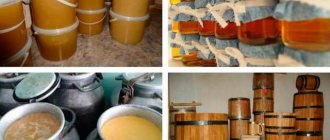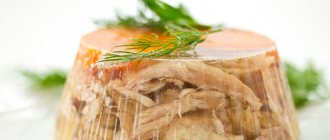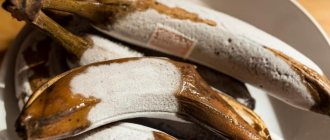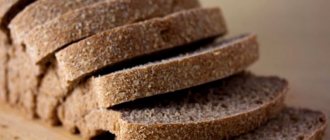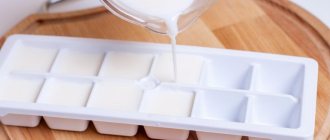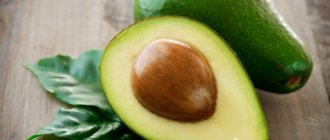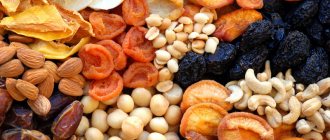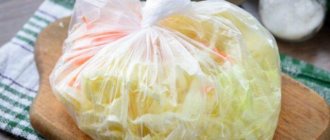Everyone loves bananas - both adults and children, and a lot has already been said about the benefits of bananas and banana peels.
Let's figure out which bananas are healthier - fresh, greenish ones, or those that have been in the kitchen for a long time, become very soft and even blackened?
We will also consider the rules for preserving and storing bananas.
Briefly about the benefits of bananas... Bananas contain easily digestible carbohydrates, as well as glucose, fructose and sucrose. In addition, bananas are rich in minerals and vitamins. Banana is a powerful antidepressant. It contains a large amount of vitamin B6. It is he who is responsible for the formation of the happiness hormone. Bananas also contain a lot of potassium, which is essential for heart function. Bananas are also essential for our blood. Yellow fruits contain a large amount of iron, which increases hemoglobin levels. Banana pulp is an excellent sorbent and cleanses the body after poisoning.
There is an opinion that bananas should be avoided during a diet, as they are rich in starch. But nutritionists do not agree with this - bananas contain malic acid, as well as enzymes, thanks to which carbohydrates are absorbed better. In addition, a banana can help the body maintain a certain level of blood sugar, so you are not at risk of attacks of uncontrolled appetite. Good news for those losing weight is that 100 g of bananas contain only 90 kcal, while bananas have no fat at all.
The right banana
As a rule, a certain variety of bananas goes on sale - Robusta moris. Also, mainly table banana varieties appear on the CIS trading floors: Gros Michel, Cavendish, Lakatan. But sometimes there is another variety (I, for example, came across it :), popularly called fodder banana. This green banana is a separate variety and not unripe bananas. The fruits are large and inedible raw. Banana chips are made from them here. You can also boil them, etc. It is sold not in fruit shops, but in vegetable shops, along with cabbage and potatoes.
Remember that the correct banana is characterized by a rich yellow color, a slightly ribbed, streamlined shape, and a shiny, smooth surface. The parameters of a high-quality banana fruit have long been determined: volume 3-4 centimeters, length 20 centimeters or more.
If the bananas are yellow, then the tail should ideally be slightly greenish, not dark. One or two bananas a day will be enough. Nutritionists do not recommend eating them on an empty stomach.
So, bananas contain a large amount of nutrients and essential vitamins that are vital for health. But a lot depends on their color.
Green bananas
The texture and flesh of green fruits is firmer than that of ripe ones. Green bananas, also called baby bananas, fill you up faster, helping you lose weight by regulating your appetite. They have a low glycemic index and control blood sugar levels.
Benefits of unripe bananas:
- Because unripe bananas have more starch, this means they contain less sugar (which is why they don't taste sweet). This may be especially helpful for people trying to avoid sugar, such as people with diabetes.
- Eating green bananas helps prevent heart problems by lowering blood cholesterol levels.
- The starch in unripe bananas can make you feel full faster and longer. This makes them a great snack between any meals. It can also help you burn more fat faster,
helping you lose weight by regulating your appetite.
They have a low glycemic index and control blood sugar levels. - Higher probiotic saturation.
Probiotics are especially beneficial for the colon. They also help improve the absorption of nutrients (especially calcium). - Green bananas are rich in vitamin B6 . It is important for nearly 100 enzymatic reactions in the body and is necessary for the production of hemoglobin, which also saturates the body with oxygen.
Yellow bananas
Ripe and yellow bananas are rich in antioxidants that fight diseases caused by free radicals in our body. They contain an ingredient called dopamine, which prevents heart disease, reduces the risk of degenerative diseases and improves mood.
Benefits of ripe bananas:
- When bananas are soft and very ripe, they are much sweeter. This happens because complex carbohydrates and sugars gradually break down into simpler sucrose over time. This means that it is much easier for the body to absorb them; this product is very useful for digestion .
- Ripe bananas contain more antioxidants. Antioxidants are good for health : they improve immunity, have anti-aging and anti-inflammatory properties.
- Yellow bananas contain magnesium, which can help you cope with insomnia, as these fruits have neuroprotective effects and relax the muscles of the body. Magnesium also lowers brain temperature and regulates hormones.
- Yellow bananas are also one of the richest sources of potassium , which is a metabolism-regulating electrolyte; It helps the body produce energy and promotes protein synthesis, which is important for the production of muscle tissue.
- Bananas also contain phosphorus , which is essential for bone health and is one of the components used to make DNA in the body.
Yellow bananas with brown spots
Ripe bananas contain much more useful vitamins and various microelements - this is also a fact proven by scientists. But here’s the most amazing thing: bananas, which are already beginning to turn black, are a source of an incredibly effective substance that can even fight cancer cells!
When a banana is already very ripe, a powerful antioxidant begins to be produced inside it, which inhibits the growth of tumor cells and prevents their spread.
Brown spots on bananas indicate the presence of TNF (tumor necrosis factor). TNF helps fight abnormal cells in the body.
Benefits of blackened bananas
Brown bananas are the sweetest and contain a lot of potassium. Such products help prevent diseases such as osteoporosis. They also contain tryptophan, which has been shown to improve mood, reduce anxiety, and promote better sleep.
Japanese researchers have found that the more a banana ripens, the more fiber, vitamin C, B vitamins, potassium and antioxidants it contains.
The older the fruit, the faster it is digested in the body, so brown bananas are best for people with digestive problems.
Eating ripe and overripe bananas is very beneficial for the immune system; this will help your body quickly cope with any infection and not catch a new one. Remember this the next time you are about to throw away an overripe banana :). Although, of course, eating a blackened banana is unpleasant not only from an aesthetic point of view - its taste also changes, and not for the better. Not to mention the consistency, which completely turns into some kind of brown mucus.
In warm weather, especially in summer, it is better to forget about BUYING “spotted” and “blackened” bananas, despite the fact that they are sold at a reduced price. Like any spoiled product, an overripe cracked banana strongly attracts fruit flies. It doesn’t matter where bananas are sold, on open trays or in stores. The sellers drive away the flies and continue selling bananas. This is the main danger. Flies penetrate under the banana peel through cracks, as well as through those very “specks” where the skin becomes very thin. While feeding on a banana, the fly lays eggs at the same time. Of course, this is not immediately noticeable; people calmly buy cheap fruit and eat it. But if you leave such bananas in a tied bag, after three days you can get a real shock when you see the number of larvae on them.
Regardless of the stage of ripeness, bananas contain a ton of nutrients per fruit. They are a great snack that keeps your blood sugar levels up and can keep your energy levels up throughout the day.
How to speed up the ripening of bananas
In order for bananas to reach the consumer fresh from southern countries, they are picked and packaged long before the ripening period - while still green. Often, after buying bananas, the consumer brings them home unripe. This problem can be easily fixed using the following methods:
- Pack the fruit in a paper bag and store for some time. Bananas have the ability to produce a gas that speeds up their ripening - ethylene. A paper bag prevents it from scattering throughout the room and speeds up the ripening of fruits. A polyethylene bag will not allow air to penetrate to the fruit, which is why ethylene will be produced more slowly. The following subtleties are important here: - put other fruits in the bag with bananas (ideally: pears, apples, quince or kiwi), which also emit such gas. - one of the ripest fruits can even be cut into pieces, which will speed up the ripening of other fruits.
- You can speed up the long ripening period of bananas if you store them indoors at a comfortable temperature (from 18 to 20 degrees). If the apartment is warmer, the fruits may ripen faster, but not too evenly. But storing the latter in conditions of high humidity can contribute to the formation of mold, which can cause them to deteriorate.
- Low humidity levels also do not improve the taste of bananas. Even fresh fruits, if stored at home this way, can lose their fresh and sweet taste. In this case, a running humidifier or small containers of water placed around the room will help.
- Green bananas that are stored correctly can ripen in 2 days. Therefore, it is important to look at them in a timely manner to prevent them from being damaged.
- You can help the fruits ripen in the oven: preheat the oven to 80 degrees (to prevent the fruits from turning black, do not exceed this mark); — place the bananas on a baking sheet previously covered with baking paper (no need to peel them); — literally after 30 minutes the bananas may darken, you don’t need to hold them for a long time so as not to spoil them; - Now put the fruit in the refrigerator or use it for its intended purpose.
- Another life hack involves freezing the fruits; it is worth remembering that this method causes them to turn black. In this case, use them to make smoothies.
Dry
Drying bananas is another way to store them. To ensure that fruits do not lose their nutritional value, they must be properly prepared. Start by choosing the right fruits. Please note that they must be dense and elastic. There should be no dark spots or dents on the peel. Peel the fruit and cut into pieces or rings about 2 mm thick. Small bananas can be dried whole either in the sun or in the oven.
Thoroughly dried fruits must be transferred to special containers. These can be plastic containers, glass jars, and even plastic bags. If the fruits are dried correctly, the shelf life will be from 10 to 12 months.
Read also: Rules for storing fruit at home
How to store homemade jam?
How can I remove scratches on a mirror?
How to properly store bananas at home
To keep fruits unchanged for longer, it is worth remembering some tricks that depend on the appearance of bananas:
- Green, with a dense, ribbed skin: these fruits are not ripe and will best be stored in a dark place at room temperature.
- Eat a ripe banana with a greenish tail and smooth peel immediately. It will keep for a day on a fruit plate on the table.
- Bananas have a dark peel, with brownish spots, and are soft in structure: they should not be stored in principle; they should be used immediately for cooking.
General principles for proper storage of bananas:
- It is best to divide the bunch into separate specimens, which will allow them to ripen evenly and not deteriorate from close contact.
- Wrap the lower part of the fruit, near the legs, with cling film, securing it securely with tape.
- To prevent accelerated ripening of fruits, it is better to store them outside of packaging or bags.
- Keep the fruits in the refrigerator; here they will ripen a little slower. To keep bananas longer and avoid dark spots, wrap each banana in cling film. Now, even after a few days, the fruit will remain fresh and beautiful. However, they can still begin to darken, which will not affect the taste in any way, but can only spoil the aesthetic appearance.
- It is best to keep bananas away from other fruits, otherwise they will not last long, helping each other in ripening due to the ethylene released.
Separately, it is worth considering the issue of storing bananas that have already been peeled. There are several ways:
- Freeze the fruits by first cutting them into discs and placing them in a plastic container. This way, bananas can last up to six months, after which you can use them as a filling for pies or chop them into cocktails.
- You can extend the life of chopped fruits by a day by soaking them in an aqueous solution of vinegar (1 to 4).
- Place the fruits in a container and hide them in a cool place.
- To protect fruits cut for the holiday table from darkening, sprinkle or grease them with lemon or orange juice.
Can I freeze it for the winter and how to do it?
Since banana fruits are not recommended to be stored in the refrigerator, the question arises whether bananas can be frozen in the freezer. Can!
Freezing is an excellent option for processing overripe fruits. This product is usually used to make chilled cocktails and dessert dishes.
The question of whether it is possible to freeze bananas for the winter may seem strange to some. But if in some region bananas are not sold all year round, then there is simply no other option!
How to do it:
- Cut the peeled bananas into slices, put them in ziplock bags, and put them in the freezer.
- Remove the peel, place the whole fruit in a plastic food container, sprinkle with lemon juice, cover with a lid and place in the freezer.
- Use a blender to make banana puree, add lemon juice, pour into silicone molds, and freeze.
The positive answer to the question whether bananas can be frozen is obvious. Proper freezing extends the shelf life to two months. In addition to all of the above, bananas can also be dried.
How long can bananas be stored?
In order not to worry about the fact that recently purchased fruits quickly deteriorate, foresee in advance why and how soon they will be needed, and based on this, purchase fruits.
- If bananas are bought for future use, with a supply of a week or more, it is better to prefer green fruits, with a hard peel, but without visible scratches, stains and damage that are not yet ripe. They do not need to be frozen, just put them in a dark place where they will keep well, gradually ripening.
- If bananas are purchased for immediate consumption , preference should be given to ripe fruits (they have a rich yellowish-straw hue, a dense peel and no visible defects on the skin). Such fruits can be stored for 1–2 days at room temperature.
- If you need the fruits for making cocktails or smoothies, buy slightly darkened bananas with brownish streaks on the peel . They have juicy pulp, which is in a mushy state. You cannot store them, because they will quickly deteriorate; it is better to clean them immediately after purchasing and put them into use.
- Fruits whose skin has a shade of gray should not be purchased at all. This color indicates that they lay in a room where it was either hot or cold or were repeatedly placed in the refrigerator; most likely, their taste will be hopelessly spoiled.
It is very important not to store bananas at home in the plastic bag in which they were packaged in the store. Fruits can rot very quickly in it. Place fully ripened bananas for storage in the refrigerator, where they (while darkening a little) can easily remain for up to 2 weeks without losing their taste.
Factors affecting the shelf life of bananas
The more seriously you choose your fruit, the longer it will last. Initially, choose only healthy fruits in the store that do not show signs of damage or a strong, cloying odor. Refrain from buying fruit on sale or buy it only if you know for sure that the bananas will be eaten in the near future. The skin of the fruit should be yellow, and the flesh should be firm to the touch; your fingers should not sink into it. In the future, the shelf life of fruits is influenced by the following factors:
- temperature. The ideal temperature range is between 12 and 14 degrees Celsius. The higher the temperature, the faster the pulp will ripen, and eventually its decomposition will begin. At lower temperatures, the fruit begins to freeze and loses its taste;
- humidity. It should not be too high, more than 90%. The optimal humidity value is from 60 to 80%. Too dry air can cause dry pulp, but, on the contrary, with high humidity, fruits begin to rot and deteriorate;
- lighting. You should not store fruits in direct sunlight, as it will provoke the fermentation process. The exception is unripe fruits.
Bananas are classified as perishable fruits. Even if storage conditions are carefully observed, the fruits are unlikely to last more than 2 weeks.
Before storing fruits, it is strictly forbidden to wash them. This will significantly reduce the shelf life.
Can bananas be stored in the refrigerator?
Some people are of the opinion that the best way to keep fruits fresh and beautiful is in the refrigerator. However, as far as bananas are concerned, it is optimal for them to be stored at a temperature of about +14 degrees, and sudden changes should not be allowed.
The ideal place for these fruits would be a basement, where it is possible to maintain the humidity level within 90%, provided that ventilation is possible. Wrap the fruits in foil, this will keep them unchanged for a week.
In general, storing bananas in the refrigerator is not the best option due to the following reasons:
- the peel may darken;
- the pulp becomes soft and mushy;
- cold speeds up the ripening of bananas, which can cause them to begin to rot prematurely;
- sharply changing heat to cold or vice versa (for example, if a bunch of bananas are taken out of the refrigerator, one is broken off and put away again) can spoil the taste of bananas and deprive them of some vitamins.
Ripe bananas stored in the refrigerator will not turn black on the inside. Only the peel will lose its aesthetic appearance, while the pulp will remain intact.
At what temperature?
When storing any perishable product, the ambient temperature is important. The only time this doesn't matter is if the fruit is scarce and you don't want to save it for later.
At what temperature should bananas be kept?
- ideally - thirteen and a half degrees Celsius;
- acceptable - from twelve to nineteen degrees Celsius;
- unacceptable - the temperature is less than ten degrees Celsius, in such conditions the fruits may turn black during the night.
Interesting fact: if the fruit darkens in cold conditions, then, once in warm conditions, it will spoil even faster.
How to prevent bananas from turning black
These fruits darken most quickly if they are exposed to cold: this can happen if the fruits were purchased on a frosty day and the owner carried them down the street for a long time or because they were stored in the refrigerator.
Bananas can turn dark because:
- They were stored in a polyethylene bag. It's best to unwrap them and leave them unwrapped.
- They began to deteriorate even on the store counter (this is noticeable by the tiny dark spots that cover the peel of these fruits).
- Bananas were stored next to apples, which actively release ethylene.
By being careful not to make these mistakes, you will prevent bananas from unsightly darkening of the skin. Although this feature, most often (if the fruit is not spoiled), does not affect their taste in any way.
conclusions
Banana is a perishable product that requires special handling. To preserve the product, it is important to observe temperature conditions and storage rules, including, in particular:
- For long-term storage, it is better to purchase green fruits, and yellow ones for consumption;
- Storage in a dark place protected from sunlight prolongs the shelf life of the product;
- Hanging in clusters also increases shelf life.
Compliance with these rules will allow you to keep the banana in a respectable form for as long as possible and will allow you to enjoy its taste without any health problems.
How to Preserve Green Bananas
To preserve green-skinned bananas without allowing them to ripen, follow these rules:
- you should not leave them in sunlight, for example, on a windowsill, especially in summer;
- It is best to place the fruit in a dark, dry place where it will not be too cold or hot;
- the ideal place for storage would be a pantry; Pack the fruits in a paper bag, ideally hang the bunches vertically (the way they hang on a palm tree while ripening);
- Do not separate the fruits from each other, as this will cause them to spoil faster.
Features of storing yellow fruits in peels
Keep bananas in their peels in a suspended state; it is better to select whole bunches in advance. The bunches should not be placed near other fruits; they will begin to deteriorate under the influence of the ethylene they release.
Where to store ripe bananas?
TOP 4 places at home where ripe bananas are best preserved:
- Cellar.
- A kitchen cabinet with no other fruit in it.
- Closed box on the balcony (suitable for the cold season).
- Food container in the pantry.
How to properly peel a banana according to etiquette
Banana is a fruit that (if it is not pre-cut into pieces) is quite problematic to eat nicely and neatly.
The rules of etiquette suggest the following:
- Before serving, wash the bananas thoroughly, dry them, cut off the top and tail, and also make small cuts along the peel on either side;
- they are served on the table on a fruit plate, lying separately from each other;
- a banana is taken from a common plate and placed on its own, intended for dessert;
- Using a special knife and fork for fruit, peel the banana;
- then the fruit is carefully cut into small pieces and put into the mouth using a fork;
- in this case, the peel remains on the dessert plate;
- These fruits are not peeled or cut in advance (before serving).
Do you want to surprise your guests? Here's an interesting life hack for you to use.
Take a needle, the length of which is at least the diameter of a banana. Clean the needle before use.
Find one of the banana seams and place the needle at the starting point. This point can be at the top or bottom of the banana.
Gently push the needle through the peel and into the banana. Push it far enough to get to the other side, but don't puncture the peel there.
Without tearing the entry point of the large hole, move the needle from side to side, creating a cut in the flesh inside the banana.
Once you feel the cut has been made, carefully pull the needle out and move it up (or down) about 1.5 centimeters along the seam and reinsert the needle. Make the next cut. Etc. Continue this process until you are finished.
In theory, it should look like this beauty. I myself, however, have not tried this method of cutting bananas...
based on materials from hoznauka.ru, vripmaster.com, takprosto.cc
Everyone has their own taste - some like greener fruits, others like sweeter and riper ones. For those who can't stand bananas that are too soft, don't worry. After all, you can prepare many different dishes from them - pancakes with banana, fruit salad, jelly...
To be healthy, it’s enough just not to reject the beneficial substances that nature itself gives you. Eat right and enjoy every moment of your life!
See also:

